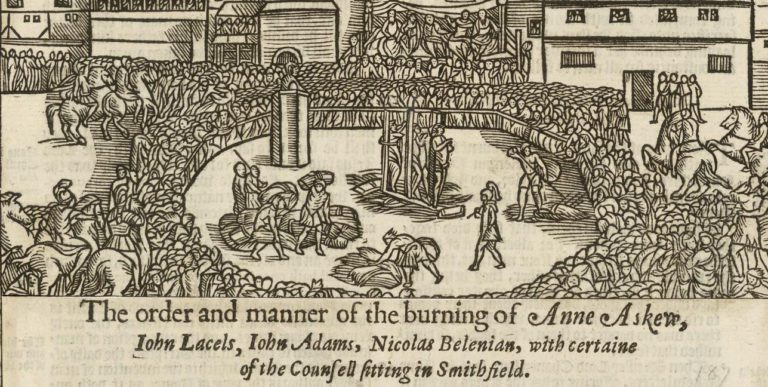Part 7 of TGCA’s series on The Apostle’s Creed
Pontius Pilate is today perhaps the best-known figure of the Roman Administration from the first century. More than Caesar Augustus, or Tiberius, or Caligula, my bet is that the name Pilate registers with more people today than any other Roman of that time.
But here’s the thing: Pontius Pilate was a light-weight. He was an ambitious, mid-tier Roman administrator, sent to the exact place no ambitious political man wanted to go: Israel—a strange place occupied by highly religious people, whose passions for their God and their traditions were likely to flare up into riots at any moment. No one wanted that job.
Yet we know Pilate’s name. To put this in perspective, it would be like time-traveller going to the year 4020, walking into a school to teach them about twentieth century history and discovering that some of the students had heard of Churchill, a few of Nelson Mandela, but that pretty much everyone knew the name of Ray Thompson, the mayor of Lithgow.
How is it that Pilate—Pilate the bit-player, the extra in the background—is the man we know about?
“Suffered”
Apart from Jesus, the Creed references two other people by name: Mary and Pilate.
Mary is associated with Jesus’ birth; Pilate with his death. Mary with his reception; Pilate with his rejection. Mary with his flourishing; Pilate with his suffering. He was born of the virgin Mary; he suffered under Pontius Pilate.
The mention of suffering and the figure of Pilate are the first indications in the Creed that there’s anything wrong with the world at all. Apart from Pilate, the story the Creed tells bounces along from the creation of the world to the birth of Jesus without so much as a hint that anything is out of place. Perhaps its authors assumed that by reading your Bible or looking out your window, you could establish something was wrong with the world all on your own? At any rate, if there’s something wrong with the world, the Creed makes no mention of it.
But then, in comes Pilate. Like a dirty dog walking into a nice room, as Karl Barth once put it. And what does Pilate do? Causes Jesus Christ to suffer. Maybe what’s wrong with the world could be summarised in the words “he”—he who touched lepers, healing the bleeding woman, declared freedom for the captives, loved his enemies—“he suffered under Pontius Pilate”.[1]
He Suffered under Pontius Pilate
The Creeds jumps straight from Jesus’ birth to his death. “Born of the virgin Mary, suffered under Pontius Pilate.” What happened to his life? What were they playing at?
Maybe it’s an omission. But maybe something profound is going on. Maybe the early Christians thought the life of Jesus could be summarised in the words “he suffered.”[2]
There’s a poem in the Old Testament, in the prophecy of Isaiah (chapter 53) that the early Christians understood as applying to Jesus. Hundreds of years before Jesus was born, the prophet wrote these words:
He had no beauty or majesty to attract us to him,
nothing in his appearance that we should desire him.
He was despised and rejected by others,
a man of suffering, and familiar with pain.
Like one from whom people hide their faces
he was despised, and we held him in low esteem.
(Isaiah 53:2-3)
The life of Jesus was very full. It was full of miracles, teaching, healing, exorcisms. He had friends. He went to dinner parties (lots of dinner parties). He travelled. He participated in religious festivals. He argued with religious teachers. He rested, caught boats, broiled fish, started riots, and fell asleep in the stern of a boat.
But there was something about where his life was heading, and how that goal shaped everything he did that meant Christians could summarise his life in two words: “he suffered.”
“Crucified”
It is almost impossible for us today to capture the strangeness of mentioning, let alone celebrating, the crucifixion of Jesus.
In the first century “crucifixion” was not a metaphor. No one said, “Oh, man, I got crucified at work today.” In fact, Roman etiquette books reminded people to never mention ‘crucifixion’ in polite company. Crucifixion was cruel and unusual by design. The whole theatre of it—the nakedness, the loss of control of bodily functions, the slowness of the death, the public spectacle as you were thrust up into the view of all—it was all calculated to bring you shame. No Roman citizen could be crucified. It was reserved for non-citizens, slaves, ethnic minorities. The Romans would happily decapitate a citizen who had committed a serious crime, but not crucify them. Come on! We have standards, people!
For a Jewish person crucifixion had an additional meaning. It meant they were under God’s curse.
Those who were crucified bore on themselves the full weight of Rome’s military might and judicial power. It declared them to be losers, non-persons. And, as their bodies were left to rot or become food for birds, they were a reminder to the rest of what happens to those who take on Roman order.
For a Jewish person crucifixion had an additional meaning. In the Old Testament law, anyone who was hung on a tree was cursed of God (Deuteronomy 21:23). A Jewish person reading their scriptures and looking at a body nailed to a cross didn’t have to wonder what it might mean. It already meant something. It meant they were under God’s curse.
Crucifixion wasn’t an empty vessel, waiting for Christians to fill it with meaning. It already meant something. Loser. Non-person. Cursed by God. These are the essential meanings of crucifixion. In the Christian faith, we are not stepping into a semantic vacuum, trying to argue that the crucifixion of Jesus meant something after all. It already meant something. We are arguing that it means something else. But what?
The clue is back there in that poem by Isaiah:
Surely he took up our pain and bore our suffering,
yet we considered him punished by God,
stricken by him, and afflicted.
But he was pierced for our transgressions,
he was crushed for our iniquities;
the punishment that brought us peace was on him,
and by his wounds we are healed.
(Isaiah 53:4-5)
The Christian faith addressed the problem of the meaning of the cross, not by going around it, but by going through it. Cursed? Yes! Punished? Yes! Crushed? Yes! But for whom? For our pain, our transgression, our iniquity.
The pulsating heart of the Christian faith is right here. God in Christ stands where we should have stood, received the punishment we should have received, died the death we should have died. He takes our place. The righteous for the unrighteous, to bring us back to God. “Oh my friend, my friend indeed, who at my need his life did spend.”
Conclusion
The Creeds mention three people from history: Jesus, Mary, and Pilate. A first century Jewish prophet, a Jewish peasant woman, and a mid-tier Roman official.
In her play, A Man for All Seasons, Dorothy L. Sayers imagines Pilate’s wife coming to report the content of a dream to her ambitious husband. Pilate asks what the dream was about. She replies:
All I can remember is a great crowd of people,” she said. “I don’t know who they were or where they were. All I remember is that they were speaking in a dozen or more languages. And they were all saying the same thing, over and over and over, ‘Suffered under Pontius Pilate, Suffered under Pontius Pilate, Suffered under Pontius Pilate.’”
[1] Myers, The Apostles’ Creed., 41.
[2] See Myers, The Apostles’ Creed., 41.















